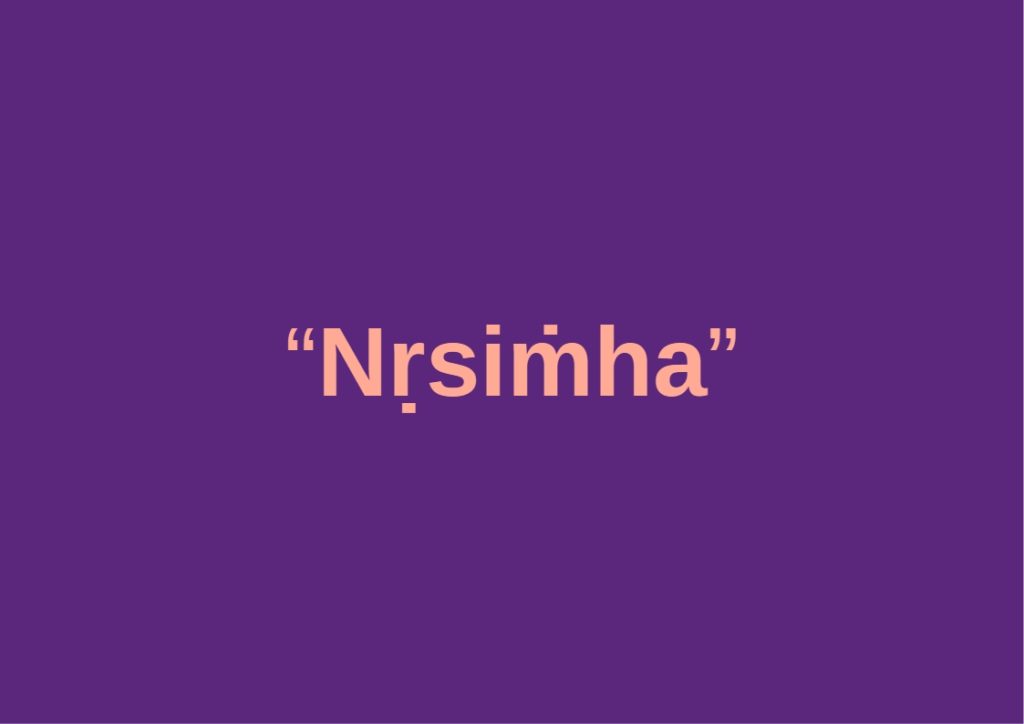What we chant in ISKCON’s daily program (continued)
Śrīla Prabhupāda’s Kīrtana Standards,” installment 34

Getting the words right
The Nṛsiṁha prayers are often mispronounced. In Nṛsiṁha that m with a dot over it indicates a Sanskrit letter pronounced as a nasal sound, as in the French word bon or like the ng in the English word thing or the geographical name Singapore. From what I’m told, North Indians and Bengalis pronounce it more like ng, South Indians more like the n in bon. In any case, the s in Nṛsiṁha is a simple s, not sh—except, I suppose, if we’re going with a more Bengali pronunciation. And the often-heard Nṛsrimha or Nasrimha—with an ri inserted after the s—is ISKCONese.
Next: In the verse that begins ito nṛsiṁhaḥ parato nṛsiṁho1 we sometimes get thrown by the different ways the word nṛsiṁha ends. The verse goes like this:
ito nṛsiṁhaḥ parato nṛsiṁho
yato yato yāmi tato nṛsiṁhaḥ
bahir nṛsiṁho hṛdaye nṛsiṁho
nṛsiṁham ādiṁ śaraṇaṁ prapadye
Now, we don’t know the grammatical rules, so the endings may seem arbitrary, unimportant, and, well, just too much bother to learn. So we may finesse the matter, perhaps sticking with a simple nṛsiṁha each time, or a simple nṛsiṁho, or a sound somewhere in between so we can’t be too far wrong. (I confess to having done this for years.)
But as with they and them, the word endings matter, so we might as well take the trouble to learn them. For those of us who don’t know the rules, we just have to memorize the way the verse goes. And then we’ll have it right ever after.
But in case you want to know:
The relevant rules are those of what is called sandhi (“combination”), rules that call for certain changes for the sake of flow when particular sounds come next to one another. (We have sandhi in English too, for example in the difference between a and an, as in a cow but an ant.)
Now, in our books we have what we generally call “four-line verses” because in the roman type they appear as four lines. But in fact these verses (such as this prayer) most often consist in Sanskrit of two lines, each made up of two parts, or pādas (in roman each shown on a line of its own). And inside — but not at the end — of each of our two-part Sanskrit lines, the rules of sandhi apply. This is so because, except when chanted responsively (as in our classes), the two parts are pronounced together, as a unit — one full Sanskrit line. And then comes the next.
For this Nṛsiṁha prayer the relevant rule is that before “soft” consonants (such as y, h, and n), aḥ becomes o. And so we have nṛsiṁho three times. (B is a soft consonant too. But bahir starts a new Sanskrit line, so sandhi doesn’t come into play.)
Of course, in kīrtana we chant each of the four pādas separately, so we could end all of them without the sandhi. But let’s not make life more complicated.2
Jaya Jaya Jaya!
Now, why at the end of the Nṛsiṁha kīrtana do we often hear “Jaya Bhakta Prahlād”? Do we ever hear “Bhakta Haridāsa Ṭhākura” or “Bhakta Rūpa Gosvāmī”? Then why “Bhakta Prahlād”?
My guess: In modern ISKCON we think we always have to end the kīrtana with “Jaya Somebody or Other,” and “Bhakta Prahlād”—picked up from an Indian movie of the same name—fits the beat.
But consider this, from a purport to Caitanya-caritāmṛta: “When a devotee is great he is called prabhu, and when he is lesser he is called bhakta, or a devotee.”3
Śrīla Prabhupāda did not chant “Jaya Bhakta Prahlād” or teach us to do so. On August 1, 1970, Śrīla Prabhupāda taught the devotees in Los Angeles how to chant the Nṛsiṁha prayers. The recording is still available.4 On that recording, there’s no “Jaya Bhakta Prahlād!” and not even “Jaya Nṛsiṁhadeva!” Śrīla Prabhupāda simply ends with “jaya jagadīśa hare.” Everything else has been added by other devotees later.
According to the notion that we have to chant the names of the Deities (“We’re personalists”), we now must chant “Jaya Nṛsiṁhadeva!” and “Jaya Prahlāda Mahārāja” (or “Jaya Bhakta Prahlād!”) and perhaps “Jaya Lakṣmī-Nṛsiṁha!” But none of this came from Śrīla Prabhupāda.
By the way: Badahari Prabhu has pointed out to me that after the maṅgala-ārātrika it is entirely permissible (and consistent) to chant the Nṛsiṁha prayers to the morning tune.5
Notes:
1 Nṛsiṁha Purāṇa, quoted in Caitanya-caritāmṛta, Antya 16.53.
2 My thanks to my grand-disciple Vāsudeva Dāsa for explaining to me these rules.
3 Cc. Ādi 6.99, purport
4 “CDV 11-7. Nrsimha Prayers.mp3.” (In “The Vintage Series,” CD 11.)
5 Personal interview, November 9, 2021.

You must be logged in to post a comment.